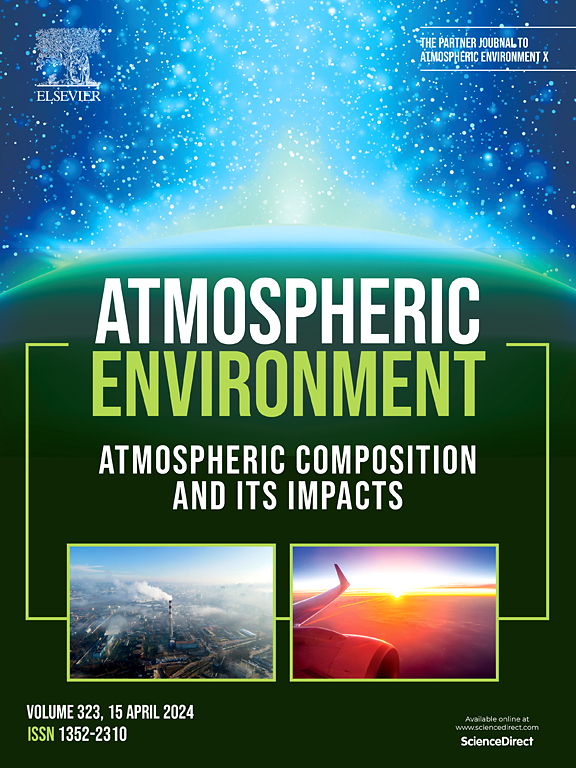求助PDF
{"title":"清洁产品和居住者产生的挥发性有机化合物对人体健康的影响和室内化学反应","authors":"Rachna Bhoonah , Maxence Mendez , Alice Maury-Micolier","doi":"10.1016/j.atmosenv.2024.120846","DOIUrl":null,"url":null,"abstract":"<div><div>Occupants and indoor activities are sources of volatile organic compounds (VOCs). We propose a framework to simulate the pollutant pathway using the INCA-Indoor© model and VOC emission rates to derive dynamic concentrations, and the USEtox model to evaluate health impacts in DALYs (Disability-Adjusted Life Years). The applicability of the framework is tested on a case study, and the effect of indoor chemical reactions on health impacts is assessed. In this case study, health impacts were of 0.3 μDALY/day without and 0.4 μDALY/day (13 s/day) with indoor air chemistry (+28 %) out of which 12 % were linked to occupant breath and skin emissions. Cleaning activities led to the highest impacts without chemical reactions (terpinolene, responsible for 0.14 μDALY/day), but indoor air chemistry led to high impacts linked to formaldehyde formation (0.18 μDALY/day). These reactions led to the formation of more formaldehyde, hence leading to 20% more impacts, in summer than in winter. Occupants’ contribution to CO<sub>2</sub> concentrations exceeded recommended limits under the given occupancy and ventilation scenario. Secondary organic aerosol (SOA) formation affected indoor particulate matter mass concentrations by up to a factor 1.2 and their number concentrations by up to a factor 25,000 in the presence of VOC emissions. Results of this study indicate that chemical reactions and SOA formation are important factors to consider in indoor air quality impact assessment. A larger number of activities and scenarios can be tested to improve the robustness of the conclusions, since, under different scenarios (for e.g. activities with lower emission rates) and with more complete toxicity data, these conclusions are likely to change.</div></div>","PeriodicalId":250,"journal":{"name":"Atmospheric Environment","volume":"338 ","pages":"Article 120846"},"PeriodicalIF":4.2000,"publicationDate":"2024-09-27","publicationTypes":"Journal Article","fieldsOfStudy":null,"isOpenAccess":false,"openAccessPdf":"","citationCount":"0","resultStr":"{\"title\":\"Human health impacts and indoor chemical reactions of VOCs from cleaning products and occupants\",\"authors\":\"Rachna Bhoonah , Maxence Mendez , Alice Maury-Micolier\",\"doi\":\"10.1016/j.atmosenv.2024.120846\",\"DOIUrl\":null,\"url\":null,\"abstract\":\"<div><div>Occupants and indoor activities are sources of volatile organic compounds (VOCs). We propose a framework to simulate the pollutant pathway using the INCA-Indoor© model and VOC emission rates to derive dynamic concentrations, and the USEtox model to evaluate health impacts in DALYs (Disability-Adjusted Life Years). The applicability of the framework is tested on a case study, and the effect of indoor chemical reactions on health impacts is assessed. In this case study, health impacts were of 0.3 μDALY/day without and 0.4 μDALY/day (13 s/day) with indoor air chemistry (+28 %) out of which 12 % were linked to occupant breath and skin emissions. Cleaning activities led to the highest impacts without chemical reactions (terpinolene, responsible for 0.14 μDALY/day), but indoor air chemistry led to high impacts linked to formaldehyde formation (0.18 μDALY/day). These reactions led to the formation of more formaldehyde, hence leading to 20% more impacts, in summer than in winter. Occupants’ contribution to CO<sub>2</sub> concentrations exceeded recommended limits under the given occupancy and ventilation scenario. Secondary organic aerosol (SOA) formation affected indoor particulate matter mass concentrations by up to a factor 1.2 and their number concentrations by up to a factor 25,000 in the presence of VOC emissions. Results of this study indicate that chemical reactions and SOA formation are important factors to consider in indoor air quality impact assessment. A larger number of activities and scenarios can be tested to improve the robustness of the conclusions, since, under different scenarios (for e.g. activities with lower emission rates) and with more complete toxicity data, these conclusions are likely to change.</div></div>\",\"PeriodicalId\":250,\"journal\":{\"name\":\"Atmospheric Environment\",\"volume\":\"338 \",\"pages\":\"Article 120846\"},\"PeriodicalIF\":4.2000,\"publicationDate\":\"2024-09-27\",\"publicationTypes\":\"Journal Article\",\"fieldsOfStudy\":null,\"isOpenAccess\":false,\"openAccessPdf\":\"\",\"citationCount\":\"0\",\"resultStr\":null,\"platform\":\"Semanticscholar\",\"paperid\":null,\"PeriodicalName\":\"Atmospheric Environment\",\"FirstCategoryId\":\"93\",\"ListUrlMain\":\"https://www.sciencedirect.com/science/article/pii/S1352231024005211\",\"RegionNum\":2,\"RegionCategory\":\"环境科学与生态学\",\"ArticlePicture\":[],\"TitleCN\":null,\"AbstractTextCN\":null,\"PMCID\":null,\"EPubDate\":\"\",\"PubModel\":\"\",\"JCR\":\"Q2\",\"JCRName\":\"ENVIRONMENTAL SCIENCES\",\"Score\":null,\"Total\":0}","platform":"Semanticscholar","paperid":null,"PeriodicalName":"Atmospheric Environment","FirstCategoryId":"93","ListUrlMain":"https://www.sciencedirect.com/science/article/pii/S1352231024005211","RegionNum":2,"RegionCategory":"环境科学与生态学","ArticlePicture":[],"TitleCN":null,"AbstractTextCN":null,"PMCID":null,"EPubDate":"","PubModel":"","JCR":"Q2","JCRName":"ENVIRONMENTAL SCIENCES","Score":null,"Total":0}
引用次数: 0
引用
批量引用


